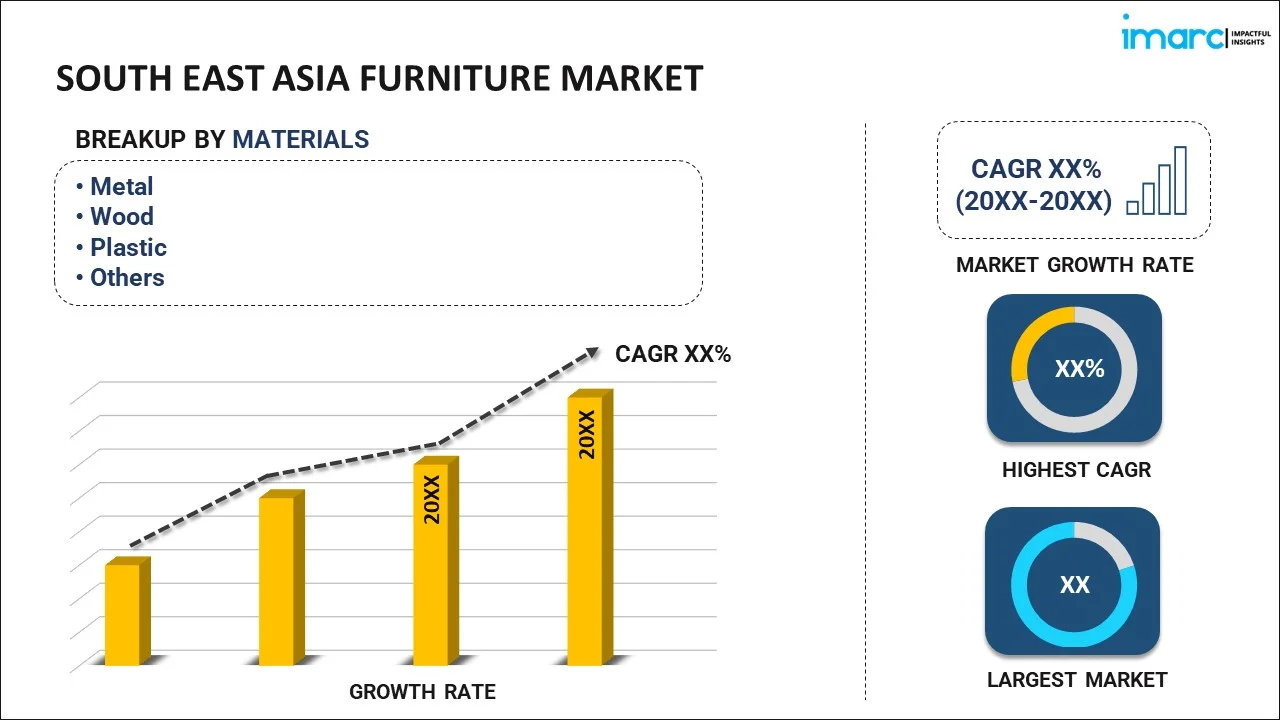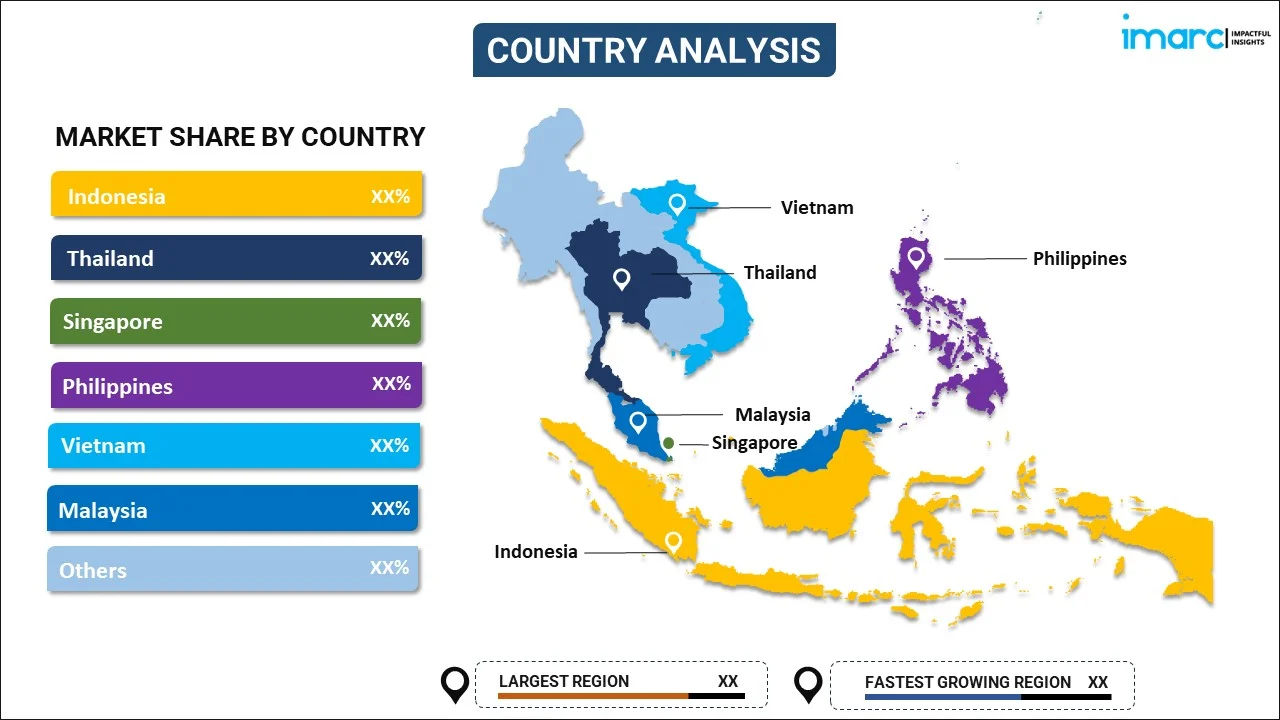
South East Asia Furniture Market Report by Material (Metal, Wood, Plastic, Glass, and Others), Distribution Channel (Supermarkets and Hypermarkets, Specialty Stores, Online Stores, and Others), End Use (Residential, Commercial), and Country 2025-2033
Market Overview:
South East Asia furniture market size is projected to exhibit a growth rate (CAGR) of 7.13% during 2025-2033. The convergence of consumer aspirations, design innovations, and the inflating popularity of modern living spaces are primarily driving the regional market.
|
Report Attribute
|
Key Statistics
|
|---|---|
|
Base Year
|
2024 |
|
Forecast Years
|
2025-2033
|
|
Historical Years
|
2019-2024
|
| Market Growth Rate (2025-2033) | 7.13% |
Furniture pertains to portable items crafted to facilitate a variety of human activities, such as sitting, sleeping, or storing belongings. This category encompasses a diverse array of objects, including chairs, tables, beds, and cabinets, typically crafted from materials such as wood, metal, plastic, and upholstery. Furniture serves the purpose of providing comfort, enabling individuals to relax, and facilitating various daily activities. Beyond its functional aspects, furniture plays a crucial role in enhancing the visual appeal of a space, contributing to an aesthetically pleasing atmosphere. It finds extensive use in residential settings, including living rooms, bedrooms, kitchens, and dining areas.
South East Asia Furniture Market Trends:
The South East Asia furniture market stands as a vibrant and evolving sector, reflecting the region's cultural diversity, economic growth, and changing lifestyles. One of the driving forces behind the growth of the market is the rising middle-class population with increasing disposable incomes. As consumers seek to enhance their living spaces, there is a growing demand for a wide range of furniture, including chairs, tables, sofas, beds, and storage solutions. Additionally, the market caters to diverse tastes and preferences, offering furniture crafted from a variety of materials such as wood, metal, rattan, and synthetic materials. Besides this, a surge in real estate development and home renovation activities further propels the demand for furniture across the region. The South East Asia furniture market is characterized by a mix of local manufacturers, regional players, and international brands. Moreover, the availability of a vast range of furniture styles, from traditional to contemporary, allows consumers to choose products that align with their preferences and interior design trends. E-commerce platforms have also played a significant role in the growth of the furniture market, providing consumers with convenient access to a diverse array of products and styles. As the region continues to experience economic growth and urbanization, the South East Asia furniture market is poised for sustained expansion over the forecasted period.
South East Asia Furniture Market Segmentation:
IMARC Group provides an analysis of the key trends in each segment of the market, along with forecasts at the regional and country levels for 2025-2033. Our report has categorized the market based on material, distribution channel, and end use.
Material Insights:

- Metal
- Wood
- Plastic
- Glass
- Others
The report has provided a detailed breakup and analysis of the market based on the material. This includes metal, wood, plastic, glass, and others.
Distribution Channel Insights:
- Supermarkets and Hypermarkets
- Specialty Stores
- Online Stores
- Others
A detailed breakup and analysis of the market based on the distribution channel have also been provided in the report. This includes supermarkets and hypermarkets, specialty stores, online stores, and others.
End Use Insights:
- Residential
- Commercial
The report has provided a detailed breakup and analysis of the market based on the end use. This includes residential and commercial.
Country Insights:

- Indonesia
- Thailand
- Singapore
- Philippines
- Vietnam
- Malaysia
- Others
The report has also provided a comprehensive analysis of all the major regional markets, which include Indonesia, Thailand, Singapore, Philippines, Vietnam, Malaysia, and Others.
Competitive Landscape:
The market research report has also provided a comprehensive analysis of the competitive landscape. Competitive analysis such as market structure, key player positioning, top winning strategies, competitive dashboard, and company evaluation quadrant has been covered in the report. Also, detailed profiles of all major companies have been provided. Some of the key players include:
- Cellini Design Center Pte Ltd
- Nhat Minh Wood Co. Ltd.
- Scanteak
- Wisanka Indonesia
(Please note that this is only a partial list of the key players, and the complete list is provided in the report.)
South East Asia Furniture Market Report Coverage:
| Report Features | Details |
|---|---|
| Base Year of the Analysis | 2024 |
| Historical Period | 2019-2024 |
| Forecast Period | 2025-2033 |
| Units | Million USD |
| Scope of the Report | Exploration of Historical and Forecast Trends, Industry Catalysts and Challenges, Segment-Wise Historical and Predictive Market Assessment:
|
| Materials Covered | Metal, Wood, Plastic, Glass, Others |
| Distribution Channels Covered | Supermarkets and Hypermarkets, Specialty Stores, Online Stores, Others |
| End Uses Covered | Residential, Commercial |
| Countries Covered | Indonesia, Thailand, Singapore, Philippines, Vietnam, Malaysia, Others |
| Companies Covered | Cellini Design Center Pte Ltd, Nhat Minh Wood Co. Ltd., Scanteak, Wisanka Indonesia, etc. |
| Customization Scope | 10% Free Customization |
| Post-Sale Analyst Support | 10-12 Weeks |
| Delivery Format | PDF and Excel through Email (We can also provide the editable version of the report in PPT/Word format on special request) |
Key Questions Answered in This Report:
- How has the South East Asia furniture market performed so far and how will it perform in the coming years?
- What has been the impact of COVID-19 on the South East Asia furniture market?
- What is the breakup of the South East Asia furniture market on the basis of material?
- What is the breakup of the South East Asia furniture market on the basis of distribution channel?
- What is the breakup of the South East Asia furniture market on the basis of end use?
- What are the various stages in the value chain of the South East Asia furniture market?
- What are the key driving factors and challenges in the South East Asia furniture?
- What is the structure of the South East Asia furniture market and who are the key players?
- What is the degree of competition in the South East Asia furniture market?
Key Benefits for Stakeholders:
- IMARC’s industry report offers a comprehensive quantitative analysis of various market segments, historical and current market trends, market forecasts, and dynamics of the South East Asia furniture market from 2019-2033.
- The research report provides the latest information on the market drivers, challenges, and opportunities in the South East Asia furniture market.
- Porter's five forces analysis assist stakeholders in assessing the impact of new entrants, competitive rivalry, supplier power, buyer power, and the threat of substitution. It helps stakeholders to analyze the level of competition within the South East Asia furniture industry and its attractiveness.
- Competitive landscape allows stakeholders to understand their competitive environment and provides an insight into the current positions of key players in the market.
Need more help?
- Speak to our experienced analysts for insights on the current market scenarios.
- Include additional segments and countries to customize the report as per your requirement.
- Gain an unparalleled competitive advantage in your domain by understanding how to utilize the report and positively impacting your operations and revenue.
- For further assistance, please connect with our analysts.
 Inquire Before Buying
Inquire Before Buying
 Speak to an Analyst
Speak to an Analyst
 Request Brochure
Request Brochure
 Request Customization
Request Customization




.webp)




.webp)












